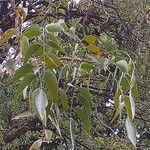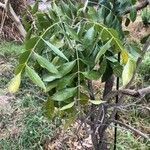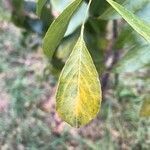Leaves up to 18(22) cm long, (2)3–6(7)-jugate; lateral leaflets up to 7(9) × 2.3(3.5) cm, falcate-lanceolate, asymmetrical at the base, acute at the apex; terminal leaflet narrowly elliptic, symmetrical; all leaflets glabrescent above, usually persistently appressed-pubescent beneath.
Slow-growing tree to 12 m.. With falcate-lanceolate leaflets in 3–7 pairs.. Racemes of blue to purplish (rarely white) flowers; standard 1.3–1.8 cm. long.. Pod narrowly oblong, flattened, few-seeded, not or tardily dehiscent, 6–9 cm. long, pubescent.
Tree, up to 7 m high. Leaves compound with 3-7 pairs of leaflets; leaflets lanceolate, up to 70 x 10 mm, base markedly asymmetric. Pods narrow, 70-100 x 10 mm. Flowers blue to mauve.
Racemes 10–20 cm long, 16–40-flowered; pedicels (7)10–20(22) mm long; bracteoles c.1 mm, usually not opposite, quickly falling.
Young branches and inflorescences and very young leaves ± densely appressed-pubescent and often sericeous.
Standard 13–18 × 13–18 mm, claw shallowly channelled; wing and keel petals ± as long as the standard.
Pod 6–9 × 0.7–1 cm, narrowly oblong, grey-brown, on a stipe 3–5 mm long at maturity, 3–5-seeded.
Smallish deciduous tree, up to 8(12) m tall, flowering with the young leaves.
Ovary with a gynophore up to 1 mm long.
Seeds 9–10 × 4.5–5 mm, grey-brown.




